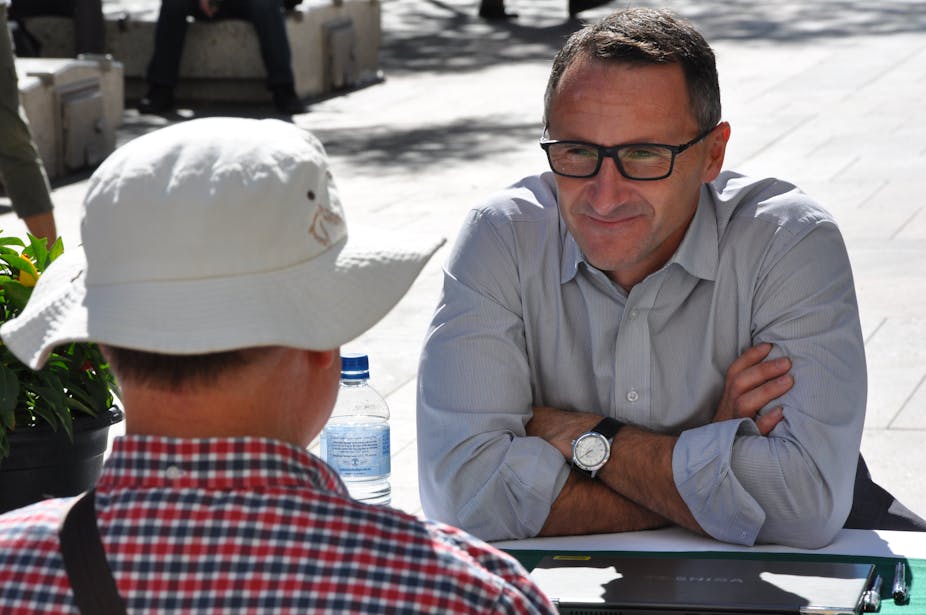The Greens are making surprisingly good strides at this election.
In the early weeks of the campaign, the Greens had Labor on the run, squeezing the ALP on penalty rates and the Safe Schools program. It even unsettled senior Labor MPs such as Anthony Albanese.
The Greens’ confident advance forced Labor to expend its energy on talking about the things that it will not do if elected, such as enter a coalition government with the Greens in the event of a hung parliament.
Labor has also been under pressure to make some important concessions in key policy areas, such as increasing the humanitarian intake of refugees in an attempt to limit the defection of its supporters to the Greens in key inner-city electorates.
But, as the University of Sydney’s Stewart Jackson has observed, the Greens typically start strongly in an election campaign before running out of puff.
Challenges and controversies
There have been challenges for the Greens. Some of these challenges are the inevitable consequence of their minor party status.
There is the persistent difficulty for the party in inserting themselves into the main election debates. For example, the major parties’ refusal to make room for Greens leader Richard Di Natale at the leaders’ debates serves to reinforce the dominance of the two main political groupings.
There is also the spectre of major party collusion, which might frustrate the Greens’ lower house ambitions.
The most recent turn of events is talk of the Liberals and Labor swapping preferences in order to protect their respective interests in key lower house seats.
Quite apart from those matters outside of the Greens’ control, there have been setbacks that are entirely self-inflicted.
Footage from 2014 of the party’s high-profile candidate for Grayndler, Jim Casey, suggesting that an Abbott Coalition government was preferable to a Shorten Labor government jarred with Di Natale’s efforts to reposition the Greens as a progressive mainstream party.
And then Di Natale made headlines for dragging his feet in declaring the family farm in Victoria as a real estate interest, and for allegedly underpaying three au pairs.
These revelations caused the party some embarrassment, particularly given its condemnation of Labor’s refusal to legislate to protect penalty rates, and on the back of their calls for Labor MP David Feeney to be disciplined for failing to declare an investment property in his electorate of Batman.
Where does this leave the Greens electorally?
Before I weigh in on this, I am obliged to state the bleeding obvious: I can only speculate as to probable outcomes.
Having made my excuses, I do think the Greens’ Senate prospects are healthy, notwithstanding the uncertainties the new Senate voting system might generate in terms of possible increases in informal votes and the impact of exhausted voter preferences.
Roy Morgan polling data indicates the Greens can win two Senate seats in Tasmania and up to two seats in Victoria and New South Wales. The party is also tracking comfortably to win one seat in Western Australia, South Australia and Queensland. A conservative estimate would be that the Greens will claim somewhere between six to nine of the available Senate vacancies.
In the House of Representatives, the party’s prospects are far more limited. In order for their candidates to gain election to the lower house, a number of things have to go the Greens’ way.
A Greens candidate must poll in either first or second place, preferably the former. A Greens candidate that polls in number-two position must hope that the difference between them and the highest-ranked candidate is less than 10%. The final hurdle is that the preferences from excluded candidates, specifically those from the Liberals, flow in their general direction.
Given this, the Greens are on track to pick up two Victorian seats: Melbourne and Batman.
Adam Bandt is very likely to retain his seat of Melbourne. In 2013, his primary vote increased by more than 7% to 42.62%, as compared to the second-placed Labor candidate, who attracted 26.6% of the first-preference vote. And according to The Australian’s Troy Bramston, Labor is “not even targeting Melbourne at this election”.
The other seat that is looking very promising for the Greens is Batman, held by David Feeney.
Feeney has made headlines in this campaign not only for failing to disclose an investment property but also for leaving highly sensitive Labor briefing documents at a Sky News studio after a disastrous media interview.
The negative publicity that has engulfed Feeney is of a magnitude that his seat is now firmly in the Greens’ sights. Privately, Labor has conceded the seat. The Greens are in a particularly strong position to take advantage of Feeney’s woes because its candidate, Alex Bhathal, has a high profile in the electorate, having contested the seat in 2010 and 2013.
Having said this, it is hard to know where the chips will ultimately fall for the Greens at this election. The party has been known to defy the expectations of commentators, such as it did at the 2015 NSW state election. But it is equally true is that the party can stumble spectacularly, as it did at the 2014 Tasmanian state election.
For now, at least, the Greens’ campaign has been steady, strategic and adaptive.

